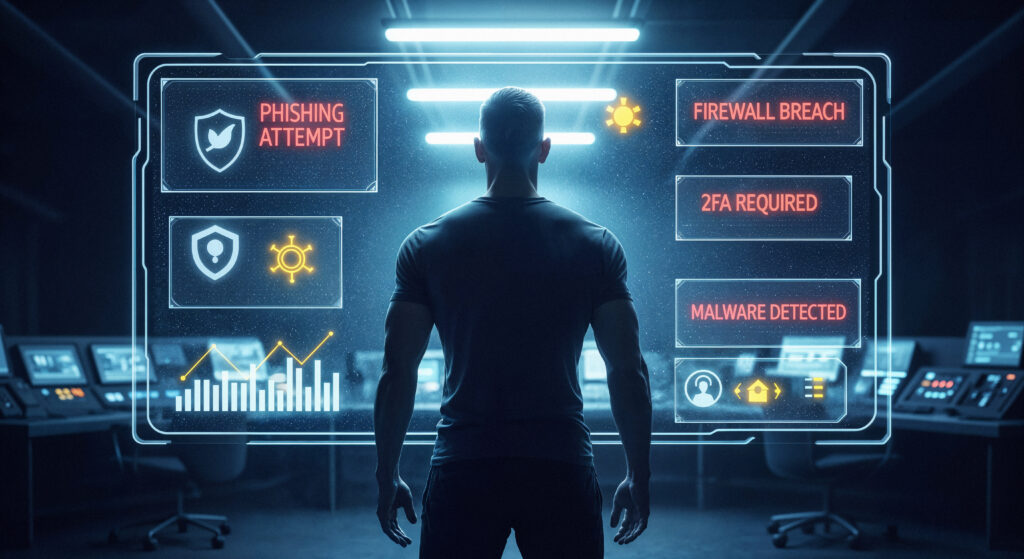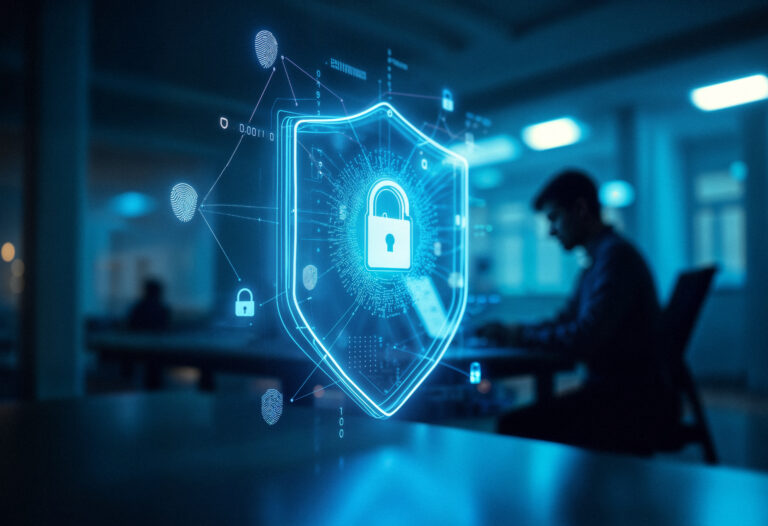Introduction
In the digital-first world, cybersecurity is no longer just a technical issue—it’s a business-critical priority. With data breaches rising every year and the cost of a single incident averaging $4.45 million globally (IBM 2023), businesses of all sizes must confront a rapidly shifting threat landscape. Cyberattacks are no longer random. They’re targeted, sophisticated, and financially or politically motivated.
Yet, defending against them isn’t easy. From securing remote endpoints and patching legacy systems to managing insider threats and maintaining compliance, the challenges in cybersecurity for business are vast, evolving, and interconnected. For many organizations, especially those without mature security infrastructure, keeping up feels overwhelming.
This article outlines the top cybersecurity challenges businesses face, the consequences of neglecting them, and the proactive steps companies can take to mitigate risks. Most importantly, it highlights the growing value of partnering with a reliable managed service provider (MSP) like Infodot, which brings both technical depth and strategic guidance to help businesses stay one step ahead.
8 Common Cybersecurity Challenges in Businesses
Businesses today face a combination of technical, operational, and human-centric cybersecurity challenges. These include external threats like ransomware, internal threats like human error, and strategic gaps such as lack of visibility or compliance readiness. These challenges must be addressed holistically to ensure resilience.
- Ransomware and phishing campaigns targeting employees
- Insider threats and compromised credentials
- Inadequate endpoint and device protection
- Outdated or unpatched systems
- Third-party and supply chain vulnerabilities
- Lack of cybersecurity awareness training
- Compliance complexity and evolving regulations
- Limited cybersecurity talent and resources
How to Mitigate Cybersecurity Challenges
Mitigating cybersecurity challenges requires a layered, proactive defense model. Organizations should combine risk-based frameworks with continuous monitoring, employee education, and expert guidance. Managed service providers (MSPs) play a key role in implementing these layers effectively.
- Perform regular risk assessments and gap analysis
- Deploy endpoint detection and response tools
- Use strong IAM and MFA controls
- Educate employees with phishing simulations
- Patch systems and update regularly
- Establish incident response plans
- Monitor cloud and third-party environments
- Engage an MSP for continuous protection
Take Action Against Cybersecurity Threats in Time to Avoid Potential Pitfalls
Delays in responding to cybersecurity risks often result in costly damage. Timely threat detection, swift remediation, and clear protocols are essential. Organizations that act before threats materialize are more resilient and compliant.
- Use SIEM for real-time threat alerts
- Automate vulnerability scanning and patching
- Maintain tested data backups
- Establish breach escalation procedures
- Simulate incident response scenarios
- Document compliance and data handling practices
- Use behavioral analytics for anomaly detection
- Integrate cyber insurance into your strategy
How Will Infodot Help Solve Cyber Security Challenges?
Infodot provides managed security services tailored for growing businesses. From 24/7 monitoring to compliance consulting, Infodot strengthens your digital defenses without overwhelming internal teams—bridging the talent and technology gap effectively.
- Managed Detection & Response (MDR) services
- Security policy creation and governance support
- Threat intelligence and vulnerability remediation
- Endpoint and network hardening
- Cloud and SaaS risk management
- Employee awareness and phishing training
- Risk-based compliance frameworks (ISO, NIST)
- Scalable, business-aligned cyber strategies
The Future of Cybersecurity: Trends and Predictions
Cybersecurity will become more predictive, automated, and AI-driven. Regulatory pressure will intensify, and attackers will continue exploiting AI, deepfakes, and third-party ecosystems. Businesses must evolve their strategies accordingly.
- AI-enhanced threat detection and response
- Zero Trust Network Architecture adoption
- Supply chain and API security focus
- Mandatory compliance audits
- Increased use of cloud-native security tools
- Cybersecurity mesh and unified security platforms
- Privacy-centric design and encryption by default
- Workforce upskilling in IT Security and Cyber Security fundamentals
Remote Workforce Security Management
Remote and hybrid models introduce new risks. MSPs ensure consistent protection regardless of user location or device.
- VPN and device encryption enforcement
- Endpoint security configuration for remote users
- Mobile Device Management (MDM) implementation
- Remote access audit and logging
- Secure collaboration tools setup
- Geo-fencing and IP whitelisting
- BYOD risk management policies
- Ongoing remote staff training
Bridging the Cybersecurity Skills Gap
With cybersecurity consulting roles hard to fill, MSPs offer instant access to specialized talent and experience.
- Security operations center (SOC) outsourcing
- Access to threat hunters and analysts
- Reduced hiring burden for in-house teams
- Round-the-clock threat monitoring
- Shared responsibility model
- Cybersecurity advisory and consulting
- Technology recommendations and implementation
- Expertise in regulatory frameworks
Security-as-a-Service for Small Businesses
MSPs make enterprise-grade security affordable and accessible for small businesses through flexible, scalable service models.
- Monthly subscription with predictable costs
- Bundled antivirus, firewall, and endpoint tools
- Scheduled patch and update management
- User and data access governance
- Backup and disaster recovery planning
- Ongoing compliance tracking
- Security dashboards and reporting
- Scalable service tiers
Implementing Proactive Cyber Hygiene Programs
Good security starts with the basics. MSPs standardize hygiene practices across the organization to reduce risk exposure.
- Password and credential management enforcement
- Patch management and system updates
- Endpoint security standardization
- Role-based access controls
- Unused service and account clean-up
- Secure system provisioning workflows
- Routine phishing awareness tests
- Activity and asset monitoring
Helping Clients Prepare for Cyber Insurance
Cyber insurance providers now demand proof of strong controls. MSPs help businesses meet these criteria efficiently.
- Security control validation and documentation
- Risk scoring and third-party audit preparation
- Network segmentation and traffic monitoring
- Data loss prevention (DLP) measures
- Policy templates for risk reporting
- Compliance attestation support
- Cyber incident history reporting
- Liaison with insurance underwriters
Cloud and SaaS Security Integration
As businesses migrate to cloud platforms, MSPs ensure those environments are secured, monitored, and compliant.
- CSPM (Cloud Security Posture Management)
- Identity and Access Management (IAM)
- Secure configuration of AWS, Azure, GCP
- SaaS usage monitoring and data control
- Secure backup and restore points
- Role-based access policies for apps
- Shadow IT discovery and management
- Compliance configuration and mapping
Real-World Examples
Real-World Example 1: Healthcare Clinic Hit by Insider Breach
A regional healthcare clinic suffered a major data leak when a disgruntled employee exported patient data to a personal device. The breach went unnoticed for weeks until it surfaced in a privacy complaint. The clinic faced HIPAA violations, reputational harm, and legal expenses.
Post-breach, the clinic implemented role-based access controls, endpoint monitoring, and DLP tools with help from an MSP. A comprehensive policy review and staff training reduced insider risk significantly. Logs are now reviewed monthly, and access anomalies trigger real-time alerts.
Lesson: Insider threats are often overlooked. Policies and monitoring matter as much as perimeter defense.
Real-World Example 2: E-commerce Retailer Attacked During Holiday Sale
During a high-traffic holiday sale, an online retailer experienced a DDoS attack that crippled its payment system. The downtime cost thousands in lost sales and triggered negative reviews. Investigation revealed no web application firewall and inadequate traffic filtering.
The business hired a managed service provider to install a DDoS mitigation solution, implement a content delivery network (CDN), and integrate 24/7 monitoring. The next year’s campaign ran smoothly, with improved performance and zero downtime.
Lesson: Downtime from cyberattacks isn’t just a technical issue—it’s lost revenue and brand credibility. Preparedness pays off.
Conclusion
Cybersecurity challenges in business are growing—not just in frequency, but in complexity and impact. From ransomware and insider threats to cloud misconfigurations and regulatory pressures, businesses are under constant threat from all directions. The cost of inaction is high, not just financially, but in terms of brand trust, operational continuity, and compliance standing.
Yet, businesses don’t have to tackle these issues alone. With the right approach—grounded in best practices and supported by expert partners—these challenges can be turned into strengths. A proactive cybersecurity posture backed by a reliable MSP like Infodot not only reduces risk but unlocks operational resilience, audit readiness, and long-term confidence.
IT leadership must view cybersecurity risks outsource and mitigation not as a checkbox or a sunk cost but as a business enabler. The digital world will continue evolving—and so will the threats. Investing in the right people, processes, and platforms today means being ready for whatever comes tomorrow.
Discover the real Benefits of Cyber Security in Business by working with a trusted partner like Infodot.
FAQs
What are cyber security challenges?
They include ransomware, phishing, insider threats, cloud misconfigurations, and regulatory complexity—each requiring distinct technical and strategic responses.
What future challenges are anticipated in cybersecurity?
AI-powered attacks, deepfakes, IoT vulnerabilities, quantum computing threats, and growing compliance demands are on the horizon.
What is the role of AI in fighting challenges in cybersecurity?
AI enhances threat detection, automates incident response, and identifies anomalies faster—reducing human workload and detection lag.
How does data privacy regulation pose a challenge for cybersecurity?
It increases the need for strong data governance, access control, and documentation to avoid non-compliance and fines.
How often should I update my cybersecurity measures?
Continuously. Tools, threats, and systems evolve. Patch weekly, audit quarterly, and reassess strategy annually or after major changes.
What’s the cost of ignoring cybersecurity?
It includes data loss, legal action, downtime, reputational damage, and recovery costs that often exceed initial prevention investments.
How do MSPs help solve cyber challenges?
They offer expertise, monitoring, compliance, and scalable solutions tailored to your risk landscape and maturity level.
Is cloud more secure than on-premises?
It depends on configuration. Cloud offers strong security tools but must be managed correctly to avoid exposure.
What is Zero Trust security?
It assumes no user or device is trusted by default—verifying every access request to reduce breach risk.
What’s the difference between a threat and a vulnerability?
A threat is a potential attack. A vulnerability is a weakness that can be exploited by that threat.
What’s social engineering in cybersecurity?
Manipulating people into giving access or sensitive data—usually through phishing or impersonation.
Can small businesses be targeted too?
Yes. They’re often easier targets due to limited defenses and less visibility in the media.
What is phishing and how to prevent it?
Phishing tricks users into revealing credentials. Prevent with training, email filtering, and link-scanning tools.
What is endpoint protection?
It secures devices like laptops, phones, and tablets—critical in remote and hybrid workplaces.
Should I get cyber insurance?
Yes. It adds financial protection but often requires strong controls to qualify.
What is ransomware and how to stop it?
Malware that encrypts your files for ransom. Stop it with backups, MFA, and patching.
How do I detect an insider threat?
Monitor unusual activity, access logs, and behavior changes. Use DLP and access controls.
What is a Security Operations Center (SOC)?
A team that monitors, detects, and responds to security events—often provided by MSPs.
What is vulnerability management?
The process of identifying, evaluating, and fixing security weaknesses in your IT environment.
What’s the best first step toward cybersecurity?
Conduct a risk assessment. Understand your assets, vulnerabilities, and regulatory landscape.
How do I measure cybersecurity performance?
Use KPIs like patch time, incident response speed, and phishing click rate.
What is threat intelligence?
Information about current threats that helps you anticipate and prepare defenses proactively.
Is cybersecurity only IT’s responsibility?
No. It’s a shared responsibility across leadership, HR, operations, and every employee.
What is cyber hygiene?
Basic practices like strong passwords, updates, and safe browsing that reduce everyday risks.
What is a penetration test?
A simulated cyberattack to identify exploitable vulnerabilities in your systems or applications.
Can AI pose a cyber risk?
Yes. Attackers use AI to automate attacks, deepfakes, or bypass controls—making AI a double-edged sword.
How often should I back up data?
Daily, ideally. Backups should be encrypted, tested, and stored separately from your main systems.
What’s the most common cause of breaches?
Human error—such as clicking phishing links or misconfiguring cloud services.
Can cybersecurity improve customer trust?
Yes. Strong cybersecurity shows customers their data is safe, building brand loyalty and trust.
What is cyber resilience?
The ability to prevent, detect, respond to, and recover from cyberattacks—ensuring business continuity.





